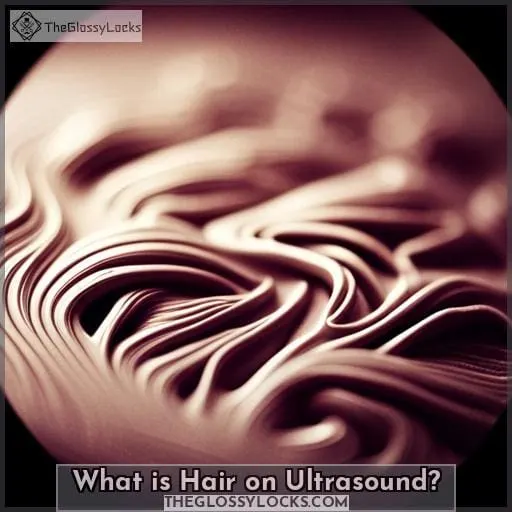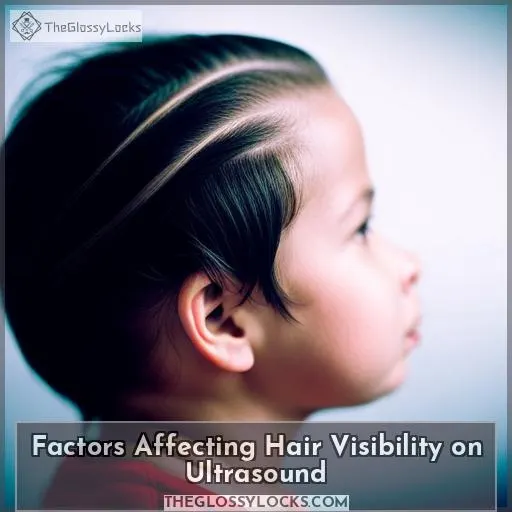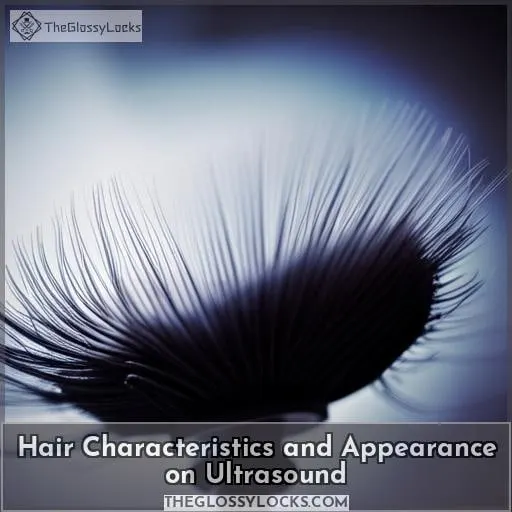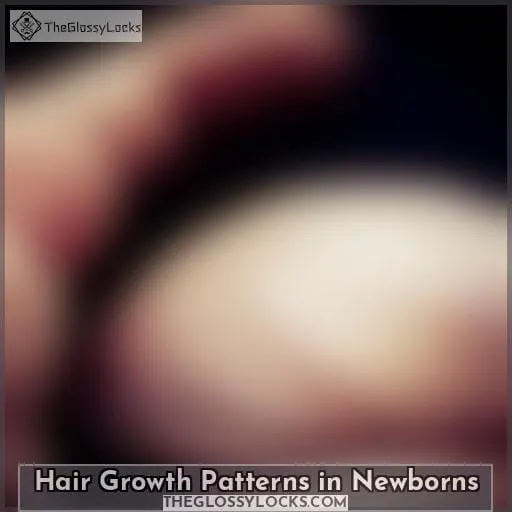This site is supported by our readers. We may earn a commission, at no cost to you, if you purchase through links.
 Unveiling the mystery of hair development in-utero, today we are taking a deep dive into what can be seen on an ultrasound scan.
Unveiling the mystery of hair development in-utero, today we are taking a deep dive into what can be seen on an ultrasound scan.
A key factor in determining whether or not you will see any visible signs of your baby’s growing locks is dependent upon a combination of hormonal influences, their developmental stage, and even settings on the ultrasound machine itself.
Hair characteristics appear differently during this time, with some babies exhibiting more noticeable tufts than others.
However, once born, these patterns become much clearer. Studies have shown that newborns’ hair typically grows faster over their first year before eventually slowing down around 18 months old.
Table Of Contents
Key Takeaways
- Factors affecting prenatal hair development include hormones, genetics, fetal position, ultrasound settings, hormonal imbalances, and prenatal conditions.
- Ultrasound scans can reveal fetal hair around 16 weeks gestation, but there are limitations in accurately predicting a baby’s appearance.
- Ultrasound settings can be adjusted to enhance hair visibility, and cowlicks observed on ultrasounds can be related to fetal movement.
- Postnatal hair development involves newborn hair growth patterns, changes in hair texture, evolution of hair color during the first year, and postpartum hair transformations, with some of these changes potentially influenced by genetic predispositions, such as hirsutism and genetics.
What is Hair on Ultrasound?

Hair can be observed on a fetus during an ultrasound scan, providing insight into what traits the baby may have when born. Hair visibility is affected by numerous factors, such as maternal age and gestational age.
The accuracy of this diagnosis varies due to the limitations of prenatal development and hair growth factors in utero.
Neonatal hair is typically more visible than that seen during ultrasound scans because it grows significantly between birth and two months after delivery. Although there are several causes for newborns having less or no hair at birth, a doctor may suggest additional tests to rule out any underlying conditions if none are detected through an initial examination or screening test before discharge from hospital care units.
Ultrasound scans cannot accurately predict every aspect of a baby’s physical appearance; however, they allow physicians to make informed decisions about potential health risks associated with pregnancy-related complications prior to childbirth.
Additionally, they provide parents with valuable information regarding their child’s physical characteristics while still in utero, which can prove helpful both emotionally and practically for preparing for postpartum life.
Hair Growth and Development in the Womb
Hair development in the womb is a fascinating process. Before birth, hair follicles begin to form and grow, often appearing on ultrasound scans as early as 16 weeks gestation. However, many parents-to-be are surprised when their newborn enters the world with different hair than what was seen during ultrasounds! This discrepancy can be attributed to several factors.
Prenatal hair development can vary due to genetic traits that may not be visible until after birth. Fetal position changes throughout pregnancy, which affects how much of their baby’s head is captured by ultrasound.
Postnatal hormonal shifts can cause babies’ hair patterns or textures to change over time.
In addition, it’s important for expectant parents (and medical professionals) alike to understand that even 3D/4D ultrasounds do not always accurately portray a fetus’ true appearance—especially regarding elements like facial features and hairstyles! Ultrasound images are only 2-dimensional representations of an unborn child within its mother’s womb.
- Prenatal Hair Development: From the formation of follicles at 16 weeks gestational age through postnatal growth cycles triggered by hormone shifts.
- Ultrasound Accuracy: Though 3D/4D images provide insight into certain aspects such as size and shape, they mustn’t necessarily predict your baby’s exact look upon arrival.
- Genetic Hair Traits: Certain characteristics might only become evident upon birth depending on genetics inherited from either parent.
Factors Affecting Hair Visibility on Ultrasound
You may be wondering how hair growth and development are visible on ultrasounds. Hormonal influences, developmental stage, and ultrasound machine settings all play a role in determining the visibility of hair during an ultrasound scan.
Additionally, differences can exist between what is seen on an ultrasound compared to when the baby is born due to changes that occur over time while in utero.
Hormonal influences on hair.
You may be surprised to learn that hormones can significantly influence the visibility of your baby’s hair on an ultrasound and when they’re born. Genetic factors, prenatal nutrition, and other environmental influences all play a role in determining the amount of hair seen during an ultrasound.
Additionally, hormonal imbalances can cause disruption in each stage of fetal hair growth before birth, leading to differences between what is seen on the ultrasound scan and how much is visible at delivery.
It’s important for expecting moms to remember that ultrasounds aren’t always accurate predictors, but it’s still fun speculating about their future child!
Developmental stage and hair.
At every stage of development, the amount and pattern of hair can vary significantly from what you may see when they’re born. Ultrasound accuracy in this regard is heavily influenced by hormonal influences as well as genetic factors like hair density.
Prenatal conditions, such as orofacial clefts or other birth defects, also affect visibility on ultrasound images. Treatment for these conditions requires close collaboration between care providers, and support groups for parents can provide helpful resources along the way.
Understanding how each factor affects hair visibility during prenatal imaging helps ensure proper diagnosis and treatment for any potential needs before their arrival into the world!
Ultrasound machine settings
To get the most accurate look at baby’s hair, you need to consider the settings on your ultrasound machine. Adjusting gain and depth can allow for more visibility of hairs in early stages developmentally.
As a result, it’s important to be aware of hormonal influences such as diabetes or smoking during pregnancy that could change your results. Additionally, medicines being taken should be kept in mind when trying to determine if certain hairs will still appear after birth.
Cleft lip and cleft palate may also come into play with regards to hair visibility since these conditions can affect how much is visible prenatally versus postnatally due to their impact on facial structure formation.
Hair Characteristics and Appearance on Ultrasound
Seeing the hair on your baby’s ultrasound can reveal a lot about their character, from curl type to color. Ultrasound visibility depends on numerous factors including prenatal development, hormonal influences, and risk factors.
Hair texture can range from fine to coarse and is usually visible by twenty-four weeks of gestation. On average, hair grows approximately half an inch (1.25 cm) per month with factors affecting hair growth. The growth rate typically accelerates in late pregnancy as hormones influence the pattern of hair formation.
Some babies have more visible locks than others at birth due to variations in genetics or environmental triggers during fetal development.
Here are some observations based on newborn hair patterns:
- Fine – may be barely noticeable after delivery but will become more evident over time as it thickens up; often appears blondish when born
- Medium – usually light brown or dark blonde; grows quickly
- Coarse – darker colors that tend toward black, browns, and red tones show up well at birth
- Curly/wavy – curls start forming around six months postpartum if not seen prenatally
On an ultrasound scan, you may also observe cowlicks which have been linked to how much movement your baby has inside the womb just prior to the delivery date. Ultimately, each individual case is unique, so expect variability between ultrasounds depending mainly on gestational age plus any additional interference like amniotic fluid levels obscuring certain areas where you would normally see hairs standing out against the skin tone background.
How Does Hair Change After Birth?
Now that you know how hair appears on ultrasound, you may be wondering what happens to it after birth.
- Neonatal Hair Growth – As babies grow and develop during their first year of life, they experience rapid growth in their scalp hairs as well.
- Infant Hair Texture – Newborns often have thick and curly locks that become finer over time due to hormone fluctuations from mommy passing through placenta before delivery day. This transformation is particularly noticeable around 2-3 months after childbirth when straightening begins occurring spontaneously as infants age further into toddlerhood years later.
- Postpartum Transformations – In general terms, most infant hairstyles will gradually start transitioning away from the original presentation towards more typical adult trends such as shorter lengths, different textures (straight/curly), and densities depending on genetic makeups amongst other factors like environmental exposure which can cause bleaching too!
Hair Growth Patterns in Newborns
You may be surprised to find out how quickly newborns’ hair can change after birth. Hair texture, neonatal patterns, and fetal follicle insights are all clues that can appear on a prenatal ultrasound.
While it isn’t always accurate due to changing hormones and environmental factors, ultrasounds provide valuable insight into what kind of hairstyle your little one might end up with.
Ultrasound scans also expose subtle features like cowlicks or bald patches, which could indicate certain styling issues later down the line, such as cowlick problems or thinning areas at specific points along their scalp as they get older.
Can Ultrasound Predict Hair Color or Texture?
Recent studies suggest that ultrasound may be able to predict the color and texture of a newborn’s hair, with some accuracy. For example, one infant was born with fine blonde locks after an ultrasound scan identified light-colored strands in utero.
However, accurately predicting fetal hair characteristics is difficult due to genetic influences on hair growth patterns during pregnancy and beyond, even when using high-resolution images from ultrasounds.
Researchers continue to make strides in understanding how sonography can help identify potential indications for future hair growth changes throughout development or immediately at birth. They examine scalp structures visible through ultrasonography scans as early as 20 weeks gestation.
These results could potentially assist clinicians in better planning for upcoming medical treatments postnatally, such as surgical interventions related to craniofacial defects or other congenital malformations that might affect scalp structure or follicular density over time.
There remain many unanswered questions regarding hair prediction using ultrasound accuracy, but continuing research shows promise towards providing us further insight into how sonographic challenges can reveal details about both fetal hair color and genetic influences leading up until delivery day.
Conclusion
To sum it up, hair on ultrasound can provide a fascinating insight into the remarkable development of a fetus in the womb. From hormonal influence and developmental stage to the settings of the ultrasound machine, it is clear that a multitude of factors affect the visibility of hair on an ultrasound.
Though it is impossible to predict the exact color or texture of a baby’s hair at birth, understanding the growth patterns of newborns can help families prepare for the big day.









